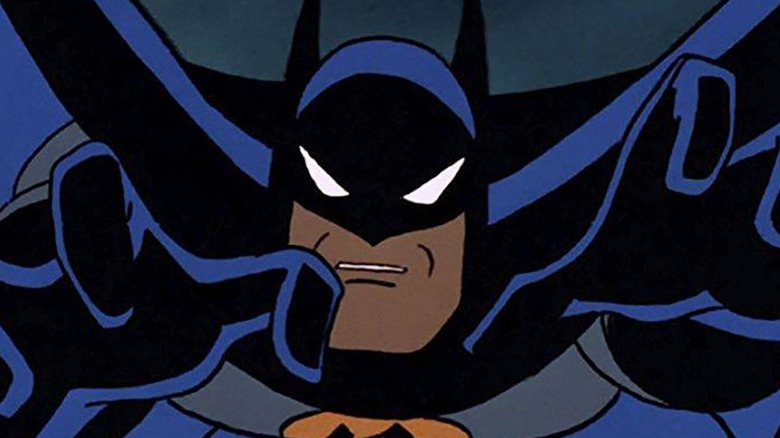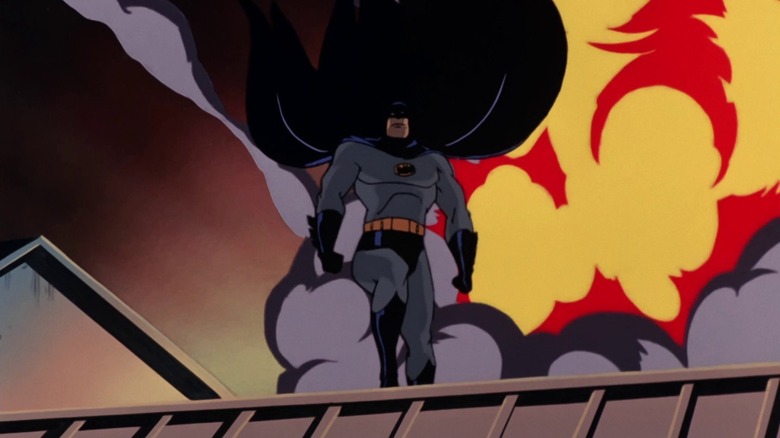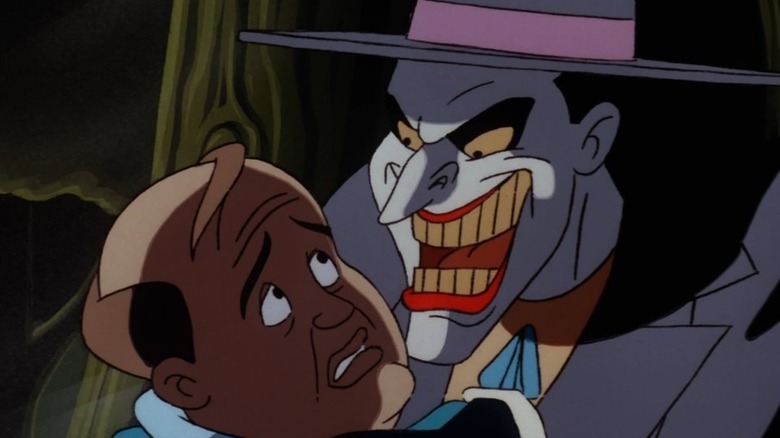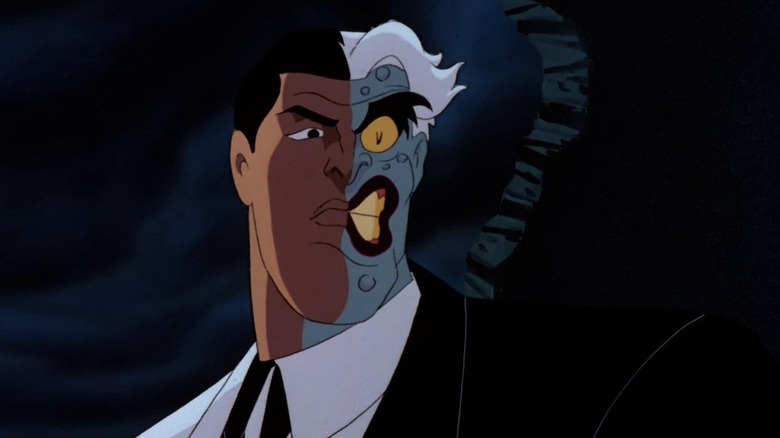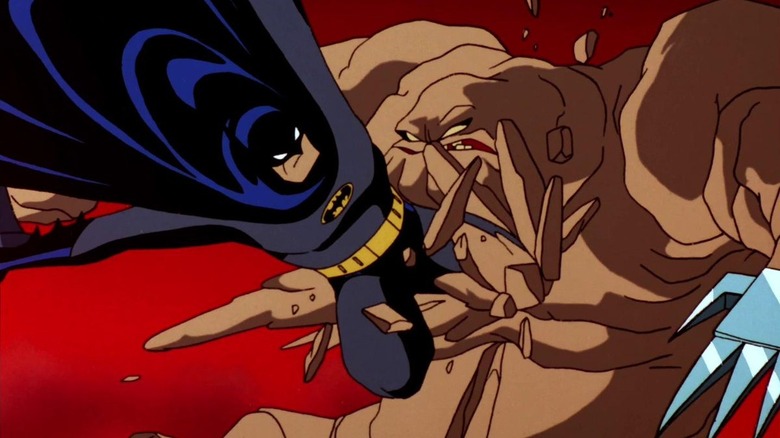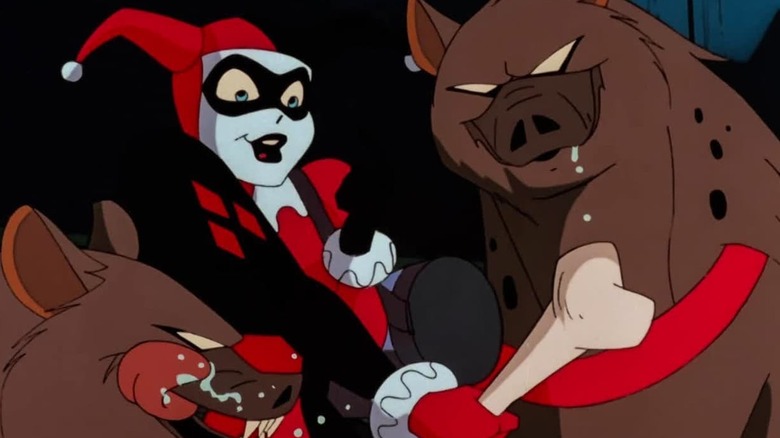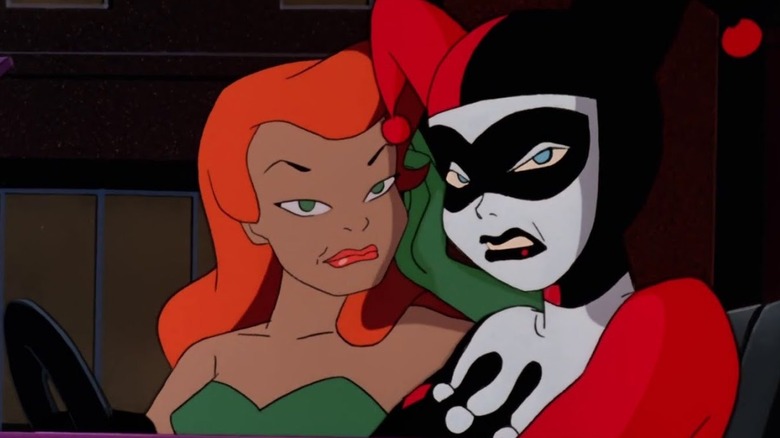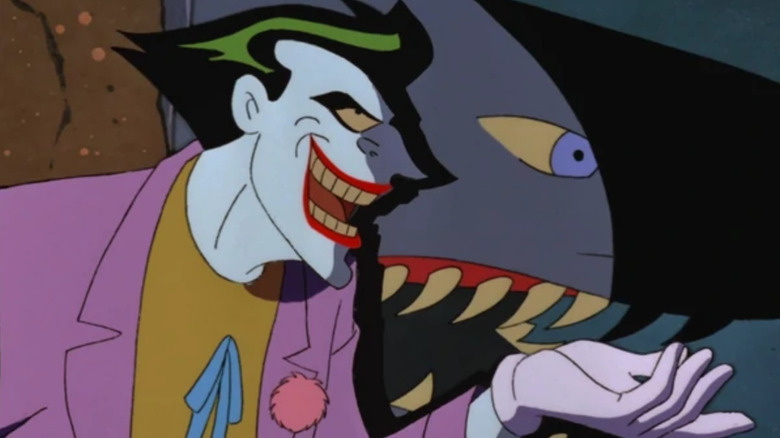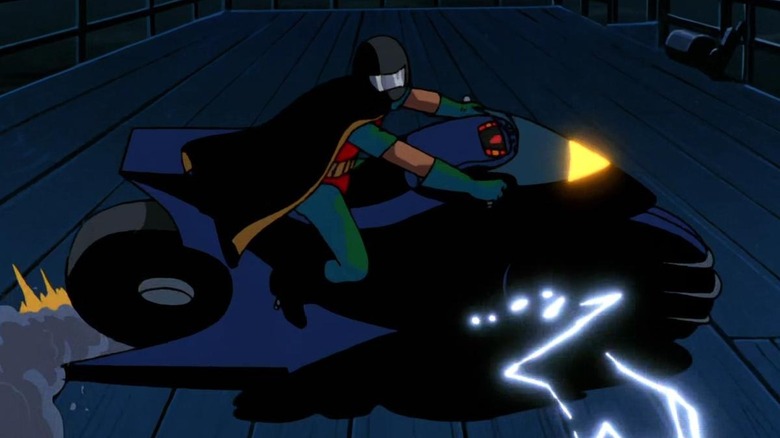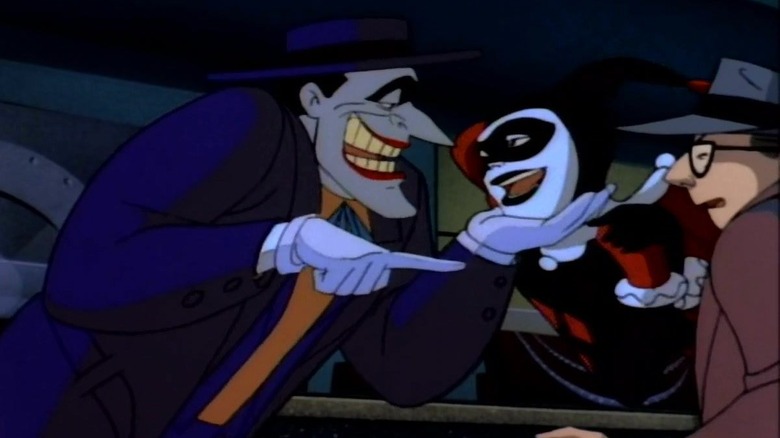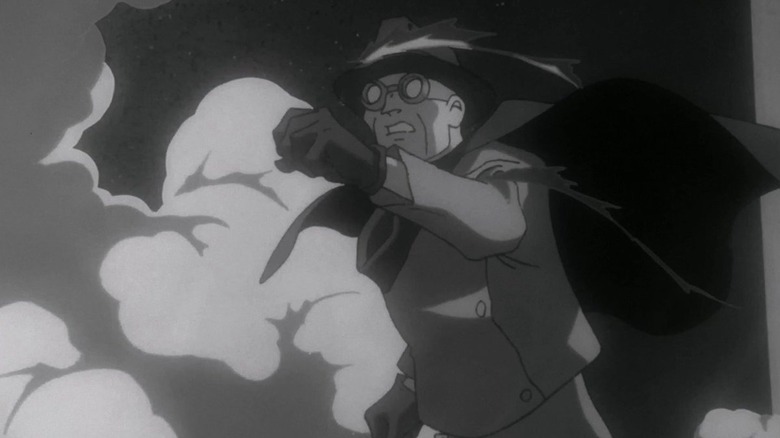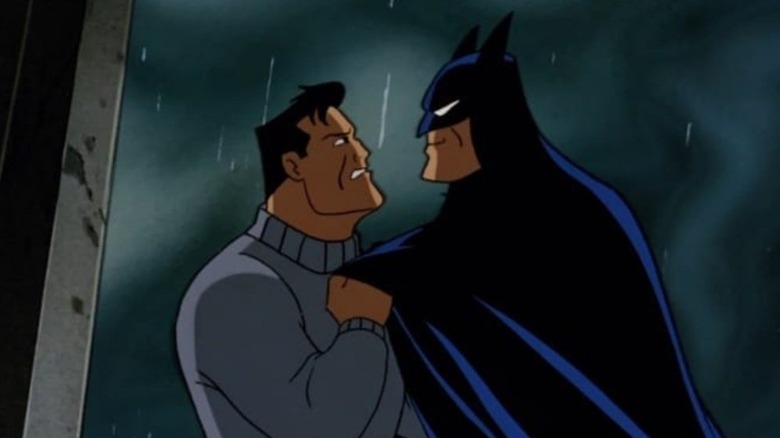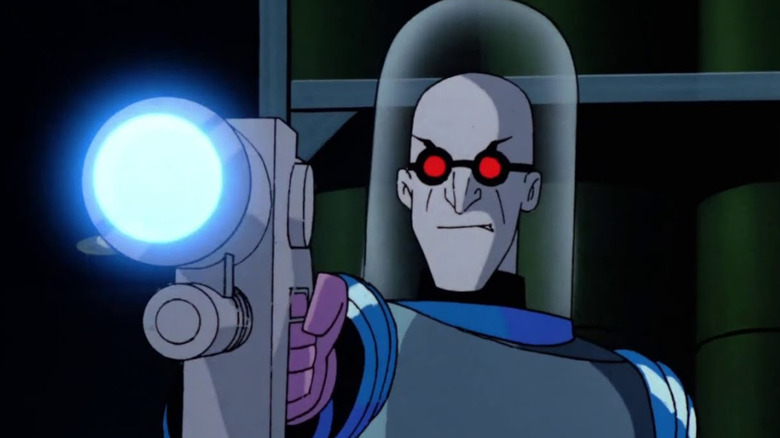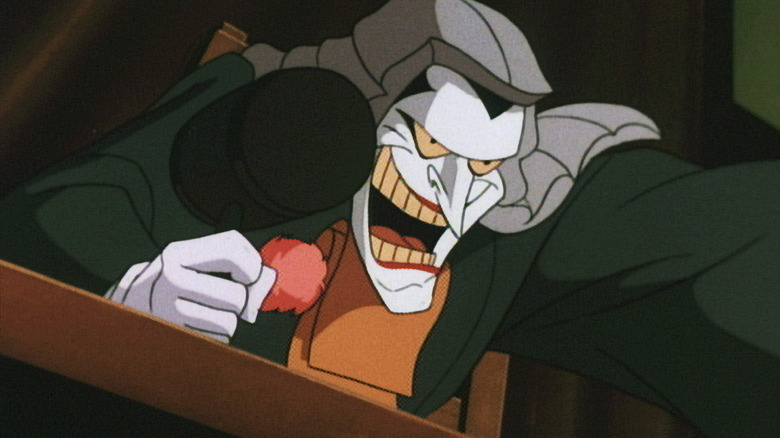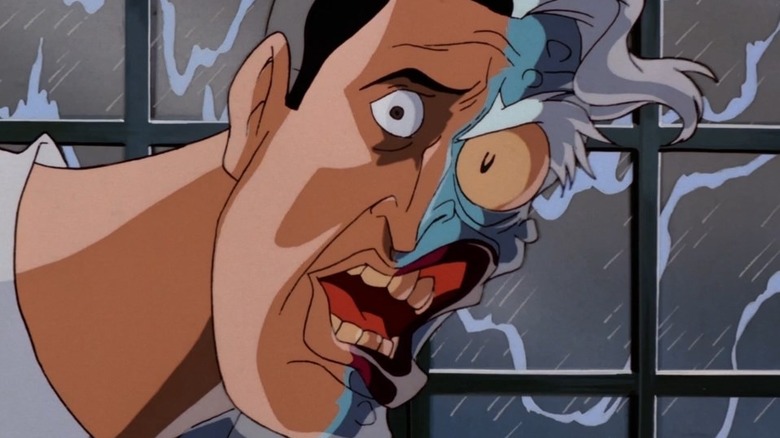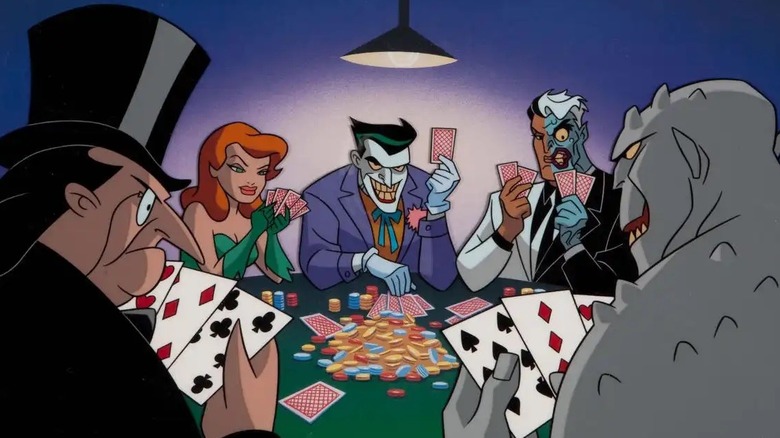The Best Batman: The Animated Series Episodes, According To IMDb
"Batman: The Animated Series" was a groundbreaking program that raised the bar for animated superhero TV shows. The series combined top-notch visuals with complex storytelling and cinematic action alongside a high-quality score and the voicework of a big-budget movie to tremendous effect. This superhero cartoon never talked down to its audience and rarely sanitized Batman's more intense comic book stories. Episodes like "Appointment in Crime Alley" and "It's Never Too Late" are powerful stories with emotional plotlines about family, loss, and regret, which feature some of the series' most genuinely moving moments. Darker, twisted episodes like "The Underdwellers" and "House and Garden," while perhaps not among the show's best, contained some of the most disturbing imagery ever seen in a children's superhero show.
In more ways than we can list, it was a revolutionary series that has been often copied, but nothing has ever been able to come close to duplicating its brilliance. In recognition of that well-deserved reputation of excellence, we're counting down the best 15 episodes of "Batman: The Animated Series," according to IMDb.
15. I Am the Night
Despite all the gunplay and violence that "Batman: The Animated Series" has become known for, "I Am the Night" is the only episode of the series where a person is actually shot on screen, and it's a doozie. As Batman somberly commemorates the anniversary of his parents' tragic death, Commissioner Gordon goes down in a hail of gunfire while out on a stakeout and spends the episode unconscious in the hospital. The shooting hits home for Batman, and it takes a toll not just on his conscience but on his identity as a superhero.
With Gordon's life hanging by a thread, the episode becomes a rare introspective story, with Batman feeling the emotional gut-punch and spiraling into an existential crisis. He begins to question his role as a superhero, asking hard questions about not just his actions as a vigilante but about the nature of crime and the value of the justice system. "I Am the Night" is the kind of story that only "Batman: The Animated Series" could tell — a thoughtful, personal story about Bruce Wayne on an introspective and spiritual journey to discover just what it means to be Batman. It's one of the darkest episodes of the series, but it at least ends on an inspirational and uplifting note.
14. Joker's Favor
"Batman: The Animated Series" gained a reputation for telling unconventional, offbeat stories, and "Joker's Favor" might be the best among them. The episode's protagonist isn't Batman or even Robin. Instead, this story is focused on the exploits of an ordinary Gotham citizen, Charlie Collins — accountant by day, loving family man by night.
However, when he has an unexpected run-in with the Joker on his way home from work, Collins promises to do the villain a favor in exchange for sparing his life. Joker plans to collect on that promise, and two years later, he tracks Collins down and forces him to help on one of his schemes. Collins sheepishly goes along with it, but frustrated by his unsatisfying hum-drum life as a "miserable little nobody" — and now tormented by the sadistic Joker — Collins finally snaps into a murderous rage.
Notable for being the first appearance of Harley Quinn, "Joker's Favor" was also the audience's first glimpse at Batman's arch-nemesis on the series. This episode demonstrated that this version of the Joker would be a much darker take on the Clown Prince of Crime than audiences may have expected. It was also the first time hearing Mark Hamill as the Joker, a role that would help define the actor's voice acting career.
13. Second Chance
In "Second Chance," we see a rare instance of a murderous villain attempting sincere treatment and rehabilitation. It's Two-Face, also known as the former Gotham District Attorney Harvey Dent, whose mental illness and violent confrontation with Rupert Thorne turn him into a criminal supervillain. Dent has been in counseling at Arkham Asylum and seems to be recovering from the disorder that caused his violent behavior. Now, only one step remains in the process — removing the physical scars of his Two-Face persona. However, there's one man who wants to stop the procedure for his own ends and kidnaps Dent before he can complete his rehabilitation.
"Second Chance" is a mix of action, drama, and whodunit mystery. Beyond that, the ultimate reveal of the individual behind the curtain turns out to be a genuine surprise, something not often seen in cartoons where story beats are often telegraphed from miles away. However, it's also a moving episode about a sympathetic villain who was once an upstanding hero and simply can't seem to put his criminal past behind him, no matter how hard he tries. The episode ends on a bittersweet note, with his Dent being visited in Arkham by his friend Bruce Wayne, who vows never to give up on him.
12. Feat of Clay
"Batman: The Animated Series" had a huge impact on the comics universe. In addition to introducing new characters to the Batman mythos like Harley Quinn, "Batman: The Animated Series" took several lesser-known villains and revamped them for the TV series, which in turn inspired the comic books, effectively making the animated versions the new standard. Such was the case with Clayface, a largely forgotten villain in the comics who had multiple origins and different depictions through the years. But "Feat of Clay" would combine elements of his classic comic book origins and create a definitive new take on the villain that has endured since its original airing.
Clayface is introduced as Matt Hagen, a struggling actor suffering from physical disfigurement who uses a compound called Renuyu to restore his appearance, supplied by corrupt business mogul Roland Daggett. However, Hagen's deal with the devil backfires when Daggett blackmails him into being a part of his criminal enterprise. When he defies Daggett, Hagen is bathed in Renuyu and becomes Clayface, a hulking, shapeshifting mud monster with beady eyes and jaws like a shark. One of the show's best episodes, "Feat of Clay" is a two-part tale that portrays Clayface as not just a violent thug, but as a tragic lost soul looking to get back against those who have wronged him.
11. Harlequinade
Harley Quinn takes the solo spotlight and gets a chance to shine on her own in the Season 2 episode "Harlequinade." After being released from prison, Quinn plays the uncharacteristic role of an ally to Batman and Robin, reluctantly helping them track down the location of a hidden atomic bomb planted by her old boss, the Joker. Unfortunately, her rambunctious nature and idiotic antics cause problems for the dynamic duo despite her good intentions, complicating the search and revealing the psychology of the girl trickster while delving into her puzzling relationship with the villain she refers to as Mr. J.
Leading them through Gotham's underworld, Harley demonstrates throughout "Harlequinade" how she uses her distracting looks and bubbly personality to hide the smart and savvy woman within. However, despite loving the Joker, her insight into his sinister criminal mind ultimately leads them to the criminal mastermind despite her attempts to lead Batman and Robin off course. When Harley betrays them, Batman plays Quinn against Joker with a series of mind games, and while the two are having it out, Robin manages to defuse the atomic bomb, saving the city and sending the pair of villainous clowns back to prison.
10. Harley and Ivy
"Batman: The Animated Series" didn't just introduce new characters and revamped favorites but also created relationships that have become central to the modern Batman mythos. Case in point is "Harley and Ivy." Matching up the two women antagonists leads to a connection that has become more than just a team-up. The pair have headlined their own comic book series, began a serious romantic relationship, and were eventually married. The pairing even carried over into the adult-oriented "Harley Quinn" animated series that debuted in 2019.
However, it all starts in "Harley and Ivy," which finds Harley thrown out of Joker's gang. On her own, Harley decides to try to get back into his good graces by robbing a museum but stumbles upon Poison Ivy, who has the same idea. Caught between the cops and their escape, the pair team up and start a string of robberies, bonding as fellow outcasts along the way. Ivy teaches Harley that she shouldn't put up with Joker's abuses, and the pair goes on a crusade against the misogynistic Gotham elite. The episode shows that there's genuinely good chemistry between the intense and bitter Ivy and the naive and exuberant Quinn, and the pairing is — as Ivy puts it — the beginning of a beautiful friendship.
9. The Laughing Fish
One of only a handful of episodes to be directly adapted from an issue of the comics, "The Laughing Fish" was based in part on "Detective Comics" #475 from February of 1978. In the "Batman: The Animated Series" episode, we see just how unpredictable and psychotic the Joker is. One minute he's a homicidal maniac, the next — as seen here — he is a master manipulator and criminal genius. As Batman says, "the Joker's insane schemes make sense to him alone."
As "The Laughing Fish" opens, all the fish in Gotham have been poisoned and now bear a pale visage, green fins, and a bright red smile. But Joker isn't out to poison the food supply. Instead, he seeks to copyright his likeness and be paid millions in royalty. Joker even takes out a TV commercial spot to advertise his Joker Fish, complete with a catchy jingle. However, the office bureaucrat who Joker makes his appeal to tells him it can't be done, putting the unfortunate man directly in the maniac's crosshairs. The clown gives the mild-mannered pencil pusher until midnight to change his mind, and so Batman and the Gotham Police Department must protect him to prevent the Joker from acting out his promise of murder.
8. Robin's Reckoning
One of the most epic stories in the series, "Robin's Reckoning" does more than tell the origin story of the Boy Wonder. It also explores the emotional core of both Batman and Robin while examining how personal tragedy has motivated them to a life of super-heroics.
When breaking up a mafia scheme, a henchman lets slip the name of his boss, Billy Marin. Robin doesn't recognize the name, but Batman does — he knows that Marin is an alias of Tony Zucco, the man responsible for the death of Robin's parents. Extended flashback scenes reveal the tragedy of Dick Grayson's parents, a pair of circus acrobats, who were killed for standing up to Zucco's corruption, and how Grayson wound up in the custody of Bruce Wayne. Those flashbacks also show a younger, more vengeance-driven Batman seeking justice for the orphan, whose situation harkens back to his tragedy.
The flashbacks shown in "Robin's Reckoning" are some of the series' best action sequences and display an emotional weight that few other episodes can match. Back in the present, Batman forbids Robin from joining him, causing a rift between them that leads to a touching exchange between the two heroes that closes out the incredible two-part episode.
7. The Man Who Killed Batman
The headline of a fallen newspaper reads in the episode's opening moments, "Batman Slain? The Mysterious Crime Fighter Missing." Presumed dead, Batman may have been killed while in pursuit of justice not at the hands of a supervillain but by a bumbling, low-level crook named Sidney. Another offbeat episode, and one that hardly features Batman at all, Sidney is the sole focus of "The Man Who Killed Batman." While he is at first happy to take credit for killing the hero (and earning the nickname Sid the Squid), he soon begins to regret the decision.
Sid suddenly realizes he's in way over his head, as he becomes the city's top fugitive with the police assuming that Sid the Squid is some new criminal mastermind. At the same time, every criminal in Gotham now wants a piece of him, including the Joker. When it is finally revealed in "The Man Who Killed Batman" that Sid isn't the master criminal he pretends to be — it turns out he stumbled and caused Batman to fall to his apparent death — Sid needs help from the hero he supposedly killed to make it out alive.
6. Beware the Gray Ghost
"Beware the Gray Ghost" brought back none other than classic Adam West to play the title hero — a masked TV crime fighter that Bruce Wayne watched as a child. The character was created specifically for this episode as a love letter to '40s and '50s superhero serials and to the 1966 "Batman" series itself, making West's casting wholly appropriate.
In "Beware the Gray Ghost," we meet once-famous actor Simon Trent, now retired and struggling to pay his bills, left behind by a city that no longer remembers him. His life is thrown upside down when he is entangled in a series of bank robberies by a terrorist called "The Mad Bomber." Since the robberies use tactics lifted from Trent's old TV show, the authorities implicate Trent himself, leaving Batman to suspect his childhood hero may have turned into a villain. Together, Trent and Batman track down the actual bomber, himself a toy collector and fanboy of "The Gray Ghost" (voiced by series creator Bruce Timm), and foil his diabolical plans. With the press noting that Batman was aided in his fight by Simon Trent, the retired actor finds renewed attention for his role as the seemingly forgotten superhero and discovers that his fans remember him after all.
5. Perchance to Dream
The life of Batman is a thrilling but lonely existence for Bruce Wayne. After all, Wayne has no family, few friends, and a virtually nonexistent love life. However, in "Perchance to Dream," Bruce wakes up with the life he might have had if not for the fateful night when his parents were killed. Engaged to Selina Kyle, the wealthy CEO of Wayne Enterprises, lives a comfortable life with Alfred tending to his estate, which is still run by his parents, Thomas and Martha Wayne.
However, things in "Perchance to Dream" aren't quite as they seem. Bruce is stricken with the nagging belief that he's the mysterious Batman, a masked vigilante that has recently started appearing in Gotham. His friends think he's crazy, but when Bruce begins to accept the simple, leisurely existence he has found himself in, he discovers clues that lead him to the truth. Bruce chases down the shadowy vigilante called Batman, which ends in a final confrontation with the Caped Crusader atop the Gotham Clock Tower, determined to find answers. It's another episode that touches on themes of identity, with Bruce Wayne once again forced to confront the nature of his role as a costumed hero, and its mind-bending premise makes it an instant classic.
4. Heart of Ice
"Heart of Ice" didn't just redefine the character of Mr. Freeze. It helped "Batman: The Animated Series" win a 1993 Daytime Emmy for outstanding writing in an animated program. No longer just a madman with a cold gun, "Heart of Ice" reveals that Mr. Freeze is actually Victor Fries, a scientist working on revolutionary suspended animation technology that he hopes will keep his wife Norah alive while a cure can be found for her terminal illness. When the company funding his work pulls the plug, he loses his wife and is doused in experimental chemicals that turn him into the frozen villain.
This tragic backstory would become the character's new origin story in comics, movies, and nearly all future appearances of the villian. "Heart of Ice" ultimately helped resurrect a relatively obscure comic book baddie and elevate him to one of Batman's premiere adversaries. More than just being an entertaining episode, it's the story of a man looking for meaning after losing his wife. It's haunting and poignant scripts like "Heart of Ice" that help "Batman: The Animated Series" continue to resonate thirty years later.
3. The Trial
In the culmination of the series' exploration of just what it means to be Batman, "The Trial" sees Batman captured and brought to Arkham Asylum for a trial put on by the inmates he has helped put behind bars. The Caped Crusader is charged with being responsible for their crimes while the Joker acts as the judge, Two-Face appears as the prosecutor, and the villains such as Poison Ivy, Killer Croc, Mad Hatter, and Scarecrow sit on the jury. Batman's defense attorney is Gotham's reluctant District Attorney Janet Van Dorn, who has never hidden her dislike for Batman. Kidnapped and forced to defend Batman against the villains she believes he helped create, she becomes part of a unique dynamic, the critic turned defender.
"The Trial" has a relatively goofy premise that, in any other hands, may have resulted in a farce. However, thanks to writers like Bruce Timm and Paul Dini, the episode serves as another example of how "Batman: The Animated Series" used comic book stories as a backdrop to explore more serious themes. In the end, Van Dorn not only successfully argues that Batman is not responsible for the creation of his villains but convinces herself of that reality as well. She eventually concludes that not only is Batman not responsible for the actions of the villains, but he's necessary to maintain peace in Gotham.
2. Two-Face
"Two-Face" is the two-part origin of the title villain, one of the biggest in Batman's impressive rogues gallery. In the opener, we meet Harvey Dent, a successful district attorney preparing for his re-election campaign by vowing to end the mob rule of Gotham crime boss Rupert Thorne. However, Dent has a hidden persona masking deep psychological damage that unleashes itself when he comes face to face with Thorne. After an accident leaves him physically scarred, Dent's sinister Two-Face persona takes over, and he ceases to be Harvey Dent.
Like the best villains on "Batman: The Animated Series," Two-Face is a tragic figure whose origin story portrays him as a sympathetic fallen angel instead of a simple antagonist. It's a portrait of a damaged man who loses himself in his ambition and whose refusal to confront his demons leads him down a dark path. "Two-Face" is a rare instance of a children's show acknowledging and normalizing mental health issues, as Bruce even encourages Harvey to see a professional, insisting that there should be no stigma around getting help. The script is full of classic scenes from Thorne, Dent, and Batman, and the reveal of Two-Face is both memorably terrifying and heartbreaking.
1. Almost Got 'Im
In "Almost Got 'Im," we see a meeting of the city's most infamous ne'er-do-wells — The Joker, The Penguin, Two-Face, and Killer Croc — gathered together for a game of poker while they hide out from Gotham's finest. As the proceedings get underway, they theorize about Batman's true nature: is he superhuman? A robot? An ordinary man with a dark past? Upon the arrival of the final member of the card-playing cabal, Poison Ivy, they discuss which one of them has come closest to offing the Batman. From there, viewers are treated to five stories, each villain claiming to have "Almost Got 'Im."
However, it's Joker's story of kidnapping Batman and torturing him on live TV when Catwoman interrupted them that gains the attention of the other villains. The Joker says that while Batman got away, he nabbed the Catwoman and has her captive right now — and will be on his way to kill her after the poker game. It's probably the series' most clever story, well-executed with great action and dramatic setups. It even includes homages to classic comic book moments. It's the finale of the episode that makes it among the best, as the evening ends with a twist that's genuinely surprising, dramatically revealing, and impossible to see coming.
